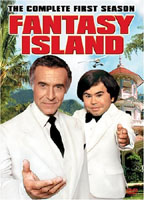 BUY IT AT AMAZON: CLICK HERE!
BUY IT AT AMAZON: CLICK HERE!
STUDIO: Columbia Tristar Home Video
MSRP: $49.95
RATED: NR
RUNNING TIME: 775 Minutes
SPECIAL FEATURES:
• Creating The Fantasy Featurette
• Original Promotional Teasers
• Spending The Day At Fantasy Island Featurette
Fantasy Island is a place where all of your wildest dreams can come true, but the lesson at the heart of the series is to be careful what you wish for. Even the most innocent fantasies can quickly turn sour in a hurry and have you begging for the fantasy to stop.
A parallel can be drawn between this typical Fantasy Island plot scenario and the show itself. It starts off strong and is everything you could have hoped for in a show, then quickly turns bad and spirals into mediocrity. It’s too bad Mr. Roarke isn’t real or else he might be able to use his mysterious abilities to save his own show and fulfill my fantasy of seeing it live up to the potential of its premise.
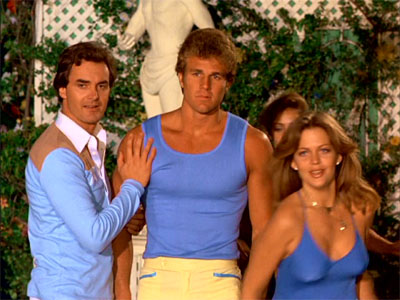
Big McLargeHuge ponders his next move.
The Show
Mr. Roarke is the owner of the wonderful Fantasy Island, where rich and poor folks alike visit in order to fulfill their greatest fantasies. The fee for living out your fantasy is fifty thousand dollars, but Mr. Roarke is always willing to make exceptions for particularly interesting fantasies. He lives in the luxurious resort on the island with his assistant Tattoo, whose primary job is to ring the bell and announce when the next plane of tourists is arriving. Once he completes that job, he’s free to go around wooing the ladies and exchange some lighthearted sidekick conversation with Mr. Roarke.
Fantasy Island started its life as a series as a mid season replacement, but the series was preceded by two full-length TV movies – Fantasy Island and Return To Fantasy Island. The original feature is almost an entirely different show in tone. Whereas the series always features happy endings and the characters always become better people, the original movie is much darker. In this feature, Mr. Roarke is willing to indulge more sinister fantasies that may end up backfiring on the guests.
The original Fantasy Island film follows the fantasies of three guests. Arnold Greenwood wants to relive his World War II romance with an American dancer. Paul Henley is an expert hunter who has made his reputation stalking dangerous game in the plains of Africa. His ultimate fantasy is to be hunted for sport by the greatest hunters in the world, but his fantasy is based more on guilt than on sport, transforming the exercise from hunting and into elaborate suicide. In the last fantasy, Eunice Baines fakes her own death and holds a funeral for herself in order to see what her relatives really think about her. Unbeknownst to her, one of the relatives knows that funeral is a phony and intends to use the opportunity to kill Eunice for real.
The darker tone of this feature makes the show feel like more of a suspense anthology than the cheerful pap it would transform into. This Mr. Roarke doesn’t feel obligated to give everyone a happy ending; he simply makes everyone’s greatest fantasy come true. Whether or not the fantasy results in a gruesome end for the guest is of no concern to him. The success of the original feature lead to Return To Fantasy Island and a transition away from the original darker premise. In this feature Mr. Roarke is still a little tricky in his methods, but all his machinations are designed to teach the guests an inner truth about themselves and give them a happy ending.
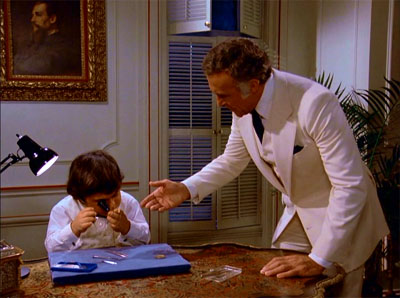
Trying to pay me in fake gold? Who do you think I am, Warwick Davis?
The rest of the series follows a standard formula. Two guests arrive, often played by B-list stars of the 1970s, and Mr. Roarke gives them their fantasy. Halfway through the fantasy, each guest is faced with a crossroads and becomes hesitant about continuing onward. Some even ask for Mr. Roarke to end the fantasy, but that option is not available on Fantasy Island. The guests will ultimately make a decision based on principle and end up learning something about themselves that they’ll take with them even after the fantasy is over.
The formulaic stories probably held up much better in a weekly format. Watching them on DVD only highlights the cookie cutter nature of the plots. It’s up to Ricardo Montalban and Herve Villechaize to carry the show. The characters of Mr. Roarke and Tattoo are primarily used as framing devices, but there relationship between the two is a great source of comedy. The show makes liberal use of a few running gags, even referencing brief conversations from the original movie. Villechaize is a great comic foil for the elegant machismo Montalban exudes and makes all the segments featuring the two worth sticking around for.
The big mystery in Fantasy Island is the exact nature of Mr. Roarke. Is he just an eccentric billionaire or something much more? As Tattoo elegantly puts it, "Some think he’s from (points upwards), some think he’s from (points downwards)." Mr. Roarke’s nature in the original movie makes it seem like either of those statements could be true, but his actions in the regular series definitely push his nature in the direction of the divine.
With just a snap of the fingers Mr. Roarke can alter the trajectory of baseballs, teleport jackrabbits and make Tattoo’s magic tricks backfire. The show could have had a much more interesting dynamic by keeping Mr. Roarke’s true motives and nature more of a mystery but chose to take it in a more lighthearted direction. The revival of the show in 1998 with Malcolm McDowell as Mr. Roarke took this direction and the "be careful what you wish for" theme, but it was not long for this world.
Fantasy Island showed true potential at its start but quickly became predictable a predicable escapist fantasy show with a "celeb of the week" theme. It’s a fluffy program that offers some humor in the form of its hosts, but the only people who will want to watch an entire season of this show are those with sadomasochistic fantasies.
5.0 out of 10
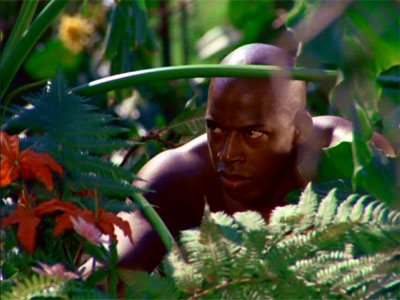
The tourists were having the best time of their lives, but little did they know that deep in the jungle lurked the dangerous tribe of Ernie Hudsons.
The Look
Fantasy Island is presented in its original full screen aspect ratio of 1.33:1. The transfer is great for a 1970s show with two exceptions. Apparently good source material was not available for the Return To Fantasy Island film and the episode Lady Of The Evening/The Racer. The transfers on these two are far below the standard of quality exhibited in the rest of the set. These two look like they were transferred from a second generation VHS tape. The picture is fuzzy and the colors are horribly muted.
The rest of the transfers include some grain here and there but great care was taken in giving the episodes a nice transfer. These transfers are so good that the studio may deserve the benefit of the doubt. If they could have found better source material for the two bad transfers they probably would have done so.
6.0 out of 10
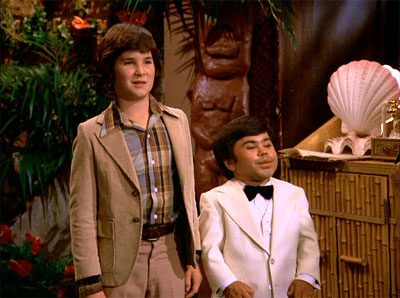
Two wild and crazy guys.
The Noise
The set includes Dolby Digital tracks in English, Portuguese and Spanish for all the regular episodes of the series. The original films only feature English tracks. Portuguese and Spanish subtitles are also included but none are present in English. It’s nice to see a real effort being made to make the show accessible to more people. All the tracks feature crisp, clear audio and ensure that the excessive amounts of gravitas exuded by Montalban’s voice remain intact.
7.0 out of 10
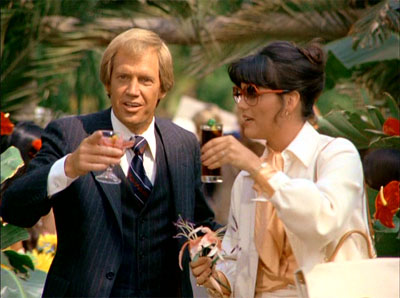
I’ll learn some inner truth about myself and be done with this cliche story in time for corn flakes.
The Goodies
The extras include two short featurettes and promotional teasers for the program. The teasers are very short snippets of the program that give viewers an idea of what’s to come. This is great for people whose attention spans are so short that they can’t sit through the opening three minutes of the show, in which Mr. Roarke tells viewers exactly what’s going to happen in that episode.
The two featurettes focus on different aspects of the program. Creating The Fantasy recounts the origins of the show and interviewers the show’s co-creator, one of the writers and one of the directors. The discuss the conversation with executives that lead to the creation of the program and how they deliberately tried to cast the most unique and non-traditional leads they could. They also discuss the original darker nature of the show and how the networks demanded a more lighthearted program for Saturday nights.
Spending The Day At Fantasy Island features interviews with some of the celebrities who made cameos on the program. Actors interviewed include Adrienne Barbeau, Joe Campanella, Ken Berry and Mary Ann Mobley. The men mainly gush about how attractive their female co-stars were and the women talk about how fun the program was and how it compared The Love Boat, the other celebrity cameo fueled program of the time. The most noticeably absent actor on both featurettes is Ricardo Montalban. He’s getting quite old now, but still makes appearances in films. The presence of the actor behind the charismatic Mr. Roarke would have made the extra features required viewing as opposed to the interesting diversions they are in their current form.
3.0 out of 10

Truth be told, Problem Child 7: Mission To Fantasy Island wasn’t nearly as good as Problem Child 3.
The Artwork
Mr. Roarke and Tattoo beckon you to purchase their DVD set as they stand in front of the magnificent villa on Fantasy Island. The discs are packaged inside two slim cases, both featuring photos of the two leads on the covers. Each disc features a different promotional photo from the series, some more garishly photoshopped than others. It’s a DVD presentation that’s attractive and saves space to boot.
7.0 out of 10
Overall: 5.5 out of 10